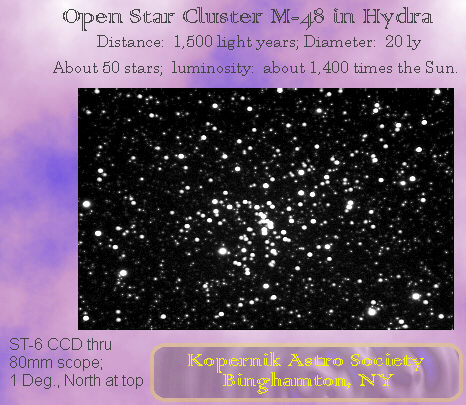

Charles Messier(February 19th, 1771):
'Cluster of very small stars without nebulosity. This cluster is a short distance from the 3 stars which form the beginning of the Unicorn's tail.'
Quote from Dreyer's New General Catalog(NGC) for NGC 2548:
Cluster, Very Large, Pretty Rich, Pretty Much Compressed, stars 9th thru 13th magnitude.
Quote from Burnham's Celestial Handbook:
Generally triangular in outline, the cluster is dominated by a central chain-like grouping of ten or so 10th and 11th magnitude stars; several dozen fainter members increase the total population to about 50 stars down to the 13th magnitude. M-48 contains three yellow giants of type G or K, but virtually all the other members are A-type main sequence stars; the brightest of these has an apparent magnitude of 8.8 and a spectral class of A2. The true luminosity of this star is about 70 times that of the Sun......... the true luminosity {of M48} is about 1,400 times the Sun.
M-48 is one of the "Missing Messier Objects" (they are M-47, M-48, M-91 & M-102). There is nothing at the coordinates provided by Messier. However, almost exactly 5 degrees directly south lies the bright cluster NGC 2548, and it fits Messier's verbal description, including being ".....a short distance from the 3 stars which form the beginning of the Unicorn's tail." Apparently Messier made a 5 degree math error, and today, all published lists of the Messier Catalog include NGC 2548 as M-48.
The best distance and diameter estimates are: distance = 1,500 light years, diameter = 20 light years. Hopefully the recent data from the Hipparcos satellite will provide accurate figures.
Click below to
George Normandin, KAS
December 26th, 1998